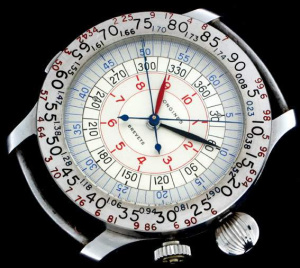Weems
Philip Van Horn Weems (March 29, 1889 – June 2, 1979) was a United States Navy officer, inventor of navigational instruments and methods, including the Weems Plotter and the Second Setting Watch and author of navigational textbooks.
Weems and his wife established the Weems School of Navigation in 1927. After Charles Lindbergh completed his celebrated solo flight across the Atlantic Ocean, the Navy assigned Weems to teach him celestial navigation for a month in 1928. Fred Noonan, Amelia Earhart's navigator on her last flight, considered him his mentor. After his first retirement, Weems wrote several books; Air Navigation (1931) was particularly well received,and was awarded a gold medal by the Aero Club of France. In 1935, he patented the Mark II Plotter.
Another invention was the Second Setting Watch - by adding a rotating 60-seconds bezel which could be locked in place, Weems created a simple way of allowing troops to align their watches' seconds hands with each other and thus co-ordinate separate military actions to the second. In old movies, when an officer tells his men "synchronise your watches", they are turning their Weems bezels. But according to the Institute of Navigation, "his proudest achievement" was the Star Altitude Curves, which simplified finding one's position; it was adopted by the Army Air Corps prior to World War II.
The Longines Weems
- The origin model
1927, the same year when Charles Lindbergh completed his famous transatlantic flight, Philip van Horn Weems, an American commander and teacher of navigation, developed the system of a new navigation watch. It allows a second-precise synchronization of the watch with the radio time signal, and without straightening the clock hands. A special bezel or a central sub-dial serves this purpose. Both are rotatably mounted and provided with a scale of 60 seconds. The watch was produced by Longines under the name "Weems Navigation Watch". The idea of Weems was later taken over by Charles A. Lindbergh, who, incidentally, was a pupil of Weems, and provided as additional element for installation in his hour angle watch. The Weems patent was awarded first place in 1935. But since that year Longines provided some of their watches with central seconds with a orientation system based on a rotating scale.
- The Longines Weems Second-Setting Watch
As a tribute to this invention in 2007 Longines, exactly eighty years after the publication of the original model, brings the "Longines Weems Second-Setting Watch" on the market. It is equipped with a mechanical self-winding movement; its power reserve is 46 hours. The round stainless steel case has a diameter of 47.50 mm. It is provided with an engraved and numbered case cover. It protects a sapphire crystal caseback, through which the current movement can be admired.
